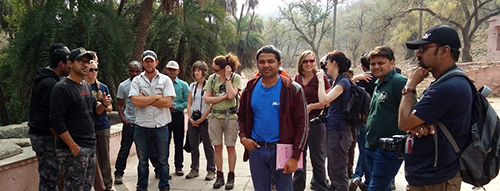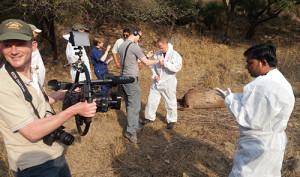February 20th (by Vamja Hitesh)
We have taken breakfast in between 7 to 8 AM then we all trainees/participants went in conference hall for routine training program in ‘’Sariska Palace’’. First topic was presented by Dr Neil Anderson he gives power point presentation on Interfaces between wildlife, domestic animals and people. He took very good lecture and gave us many knowledge and understandings about Interfaces between wildlife, domestic animals and people. After finishing the lecture he divided us in four different groups, 5 members in each group. He gave us 4 different questions as following for field exercise and discussion.
- What are the contact points and mechanisms for disease transmission?
- Is there any spatial or temporal separation between hosts?
- What species are most at risk?
- What diseases are likely to be of concern?

At 9:00 AM we get in to the bus for our field exercise in Sariska National Park. After some time we reached Pandupol Hanumanaji temple. Mr. Dipendu taught us the history of pandupol Hanumanji temple. He said that it’s an oldest temple and it is believed that the Pandavas (Yudhishtar, Bhim, Nakul, Sahdev and Arjun) were passes through that place and at that time there were no space for walking through that path. There were many monkeys seating on a way. Among them one god monkey have said that just hold up my tail and walk behind me I will pass you all from this path. So for that purpose this place is famous among people. People are giving food to rhesus macaques and common langurs as a faith that the foods we give to these monkeys were directly reached to god monkey. There is a dustbin build up by concrete and cement. Dusts were thrown inside it this thing was really very good for forest and environment which helps to keep clean the forest. Then we all go in the temple for prey and after preying meet together just near to temple and Dr. Anna gave some instructions about our field work then we all separate for our field work according to distributed us. We have finished our work and observations in the field within 1.5 hour and get in to bus for ‘’Sariska Palace’’, on the way we took a small breakfast.

On a way from Pandupol Hanuman temple to ‘’Sariska Palace” we found one dead body of an adult male sambar just near to road side. We stop our bus and observed the carcass. Dr. Parag Nigam gave us some information about the dead body and then decided to arrange the Postmortem Examination at 3:30 PM. Then we reach to ‘’Sariska Palace’’ and took our sweet lunch. We gathered in library at ‘’Sariska Palace’’ for discussion about given questions and then prepare a graphs for presentation at 3:00 PM. We get into bus at 3:45 PM for PM examination of sambar. We reached at site of PM examination. We all trainees have given different works during PM examinations. PM examination was performed under guidelines of Dr. Tony, Dr. Parag Nigam, Dr. Pradeep Malik and Prof. Anna. We gain much knowledge about protocol and complete procedure of PM examination. Then we came to ‘’Sariska Palace’’ for discussion about questions given in field work. All groups have given their opinions according to field observations and the conclusions were as below:
- Contact points are road, vehicles, water sides, feeding platform, trees, vector borne, faeco-oral, fomites and fighting.
- Spatial seperations are vehicle, birds in tree and bats.
- Temporal seperations are nocturnal specieses and human during day.
- Species at risk are human, monkeys, dogs, pigs, birds, domestic and wild ungulates.
- Diseases likely to be concern are FMD, TB, campylobacteriosis, coccidiosis, leptospirosis, rabies, herpes, salmonella and campylobacteriosis.
After finishing discussion we take dinner and then go to our rooms.
Training is really very helpful for us to gain much more knowledge about different practical aspects and also for our technical aspects and all the tutors are teaches us very enthusiastically and calmly and give solutions of our confusions very satisfactory.
Leave a Reply